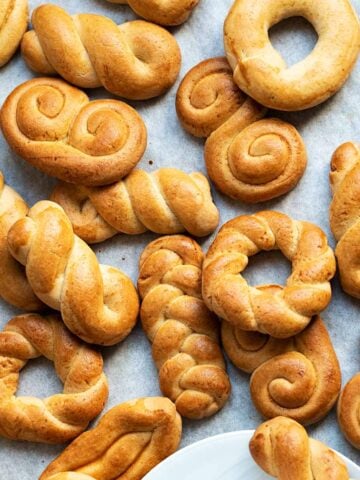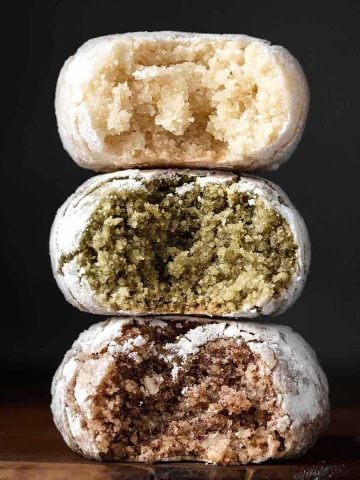A traditional recipe for double-baked olive oil cookies with almonds. These Greek Paximadia (or better yet, paximadakia) are similar to biscotti—tender, crunchy, delicious, and naturally vegan!

You probably know them as Paximadia, but in Greece, we call them paximadakia (it's the diminutive form). These Cretan biscuits are very similar to their Italian cousins (biscotti), except that they’re naturally vegan!
They are my favorite cookies, and I’ve been waiting a long time to share this recipe with you! I dare say this recipe for double-baked olive oil cookies is one of the best cookie recipes you'll ever make
And as most Cretan traditional recipes, it is unbelievably easy, since it doesn’t require a mixer or other kind of fancy equipment, not to mention a whole lot healthier because it’s made with olive oil instead of butter. All you'll need to make them is just a bowl and a whisk. And maybe not even a whisk. My grandma used to mix everything with her hand! Additionally, these paximadakia are naturally vegan since they contain no eggs or any other animal products. In a way, they are a lot like this olive oil & tahini chocolate cake, but without the chocolate and the tahini 🙂
For more Greek cookie recipes, don't miss these Koulourakia (Greek Easter cookies) with a buttery, melt-in-your-mouth texture and a guide for 12 different shapes, these Greek Kourabiedes made for Christmass but also for engagements and my favorite Melomakarona (honey spiced cookies).

In Crete, these cookies are also called “Kalorizika” which means “fortune cookies” or more accurately “good fortune cookies”. They are made as a treat for special occasions like engagements and weddings to signify the couple's good fortune and longevity – nuts and grains symbolize prosperity and fertility in Cretan tradition. That’s why almonds, walnuts, and rice play a major role in these kinds of celebrations.

These cookies, like most biscotti, are double baked so that they dry out and become extra crunchy. This is something that helps them keep for a long time. And I mean a LONG time!
In the recipe box, I tell you that they keep well for at least 15 days, but my mother keeps them even for over a month without any problems! The double baking process is very simple. First, you form loaves, cut them up vertically without separating the pieces and bake them as you normally would.
When done, you wait for them to cool, separate the cookies into individual biscotti, lay them the one next to the other in the baking pan and bake them for a second time at a lower temperature.
The second baking dries them out, making them extra crunchy! If you'd like, you can reserve some and eat them soft without baking them for a second time, but keep in mind that they will become stale after two or three days.
Some notes/tips:
You can use half olive oil and half vegetable oil instead of all olive oil, for a lighter olive oil taste.
Don’t use too much flour! The more you use, the tougher they’ll get!
These biscotti keep really well! Store them at room temperature inside an airtight container for up to 15 days or more!
If you can’t find raki use grappa. If you can't find grappa, use kirsch or vodka.
Some people like to use grounded mastic (about 2 tears) and almond extract (2-3 drops) as additional flavorings, but I usually don’t.
Super important: They are delicious dunked in hot coffee!
📖 Recipe

Paximadia Recipe: Double—baked Greek cookies
Ingredients
- 1 cup (230 g) olive oil (or half olive and half other vegetable oil)
- 1 cup (200 g) sugar
- ½ teaspoon cinnamon
- ¼ teaspoon ground cloves
- ¾ teaspoon baking soda
- ½ teaspoon fine salt
- ½ cup (120 g) orange juice
- 2 tablespoons (30 g) Raki (or Grappa, Kirsch, or even vodka.)
- 1 teaspoon vanilla
- 1 orange (the zest)
- 4 ½ cups (560 g) all purpose flour
- 4 teaspoons baking powder
- ½ cup (120 g) roasted almonds, (chopped or roughly processed in the food processor (measure them chopped))
Instructions
- In a bowl mix together the sugar, cinnamon, cloves, baking soda, and salt.Add the olive and mix with a whisk (or with your hand) until sugar is almost dissolved.Add the orange juice, raki, vanilla, orange zest, and mix to combine.
- In another bowl mix 4.5 cups of the flour (580 grams) with the baking powder and the almonds and add them to the olive oil mixture.Mix gently until just combined and set aside for 15 minutes to rest.
- Preheat oven to 356°F (180°C) and line a baking pan with baking sheet.
- After 15 minutes, you should have a soft but pliable dough that doesn’t stick to your hands. If it is sticky, add some extra flour, until pliable.Divide mixture into 4 equal parts and shape 4 cylinders, approximately 1.5 inches (4 cm) in diameter.
- Place cylinders on the pan, leaving some space between them because they will spread out a bit.Using a knife or another sharp object, cut each cylinder vertically (like the picture) into slices (about 0.5 inch thick) but don’t separate the pieces.
- Bake for 30-35 minutes, or until golden. Let them cool.
- Preheat oven to 300°F (150°C).
- Using a sharp knife cut and separate the biscotti and lay them flat, the one next to the other, on your baking pan.Bake for about 20-30 minutes or until browned.Let on a rack to cool.Eat!
Notes
Nutrition
If you like this recipe, Pin it!







Kathryn Pauline says
Oh my goodness. Must, must, must try these soon.
Makos says
Please do! As far as I'm concerened, these are the most amazing biscotti you can find...
Erin says
Do these bake up hard and crunchy or crisp and tender? I've never scored or pre-sliced the former logs before the first bake. Does that help them to bake more evenly? Thank you
Makos says
Hi Erin!
These biscotti are somewhere in the middle. The're definitely crunchy, but not as hard as traditional biscotti, so I'd say they're tender and crunchy. Be carefull not to use too much flour since they'll harden (though they will still be delicious!) Hope this helps!
Slicing them before the first bake will help you to slice them afterwards without breaking them (since they'll be tender) and with minimal crumbs.
Jane says
Hi – I made these and they were insanely good, so good that they were devoured almost instantly and I have to make another batch! Was wondering whether I could increase the amount of raki? Also, I noticed that you don’t dissolve the baking soda in the orange juice as many recipes do- any reason for this?
Makos says
Hi Jane,
So nice to hear that! I too, have to say that when I start eating these it's impossible to stop!
I haven't done this, but you could increase the raki and decrease the orange juice by the same amount (maybe 2-3 tablespoons?).
My mom also mixes the baking soda in the orange juice in a glass over the bowl (because it bubbles over) but I find that if you mix it with the dry ingredients, the biscotti become a little more tender because all those bubbles form inside the dough (maybe it's just my idea though, haha!).